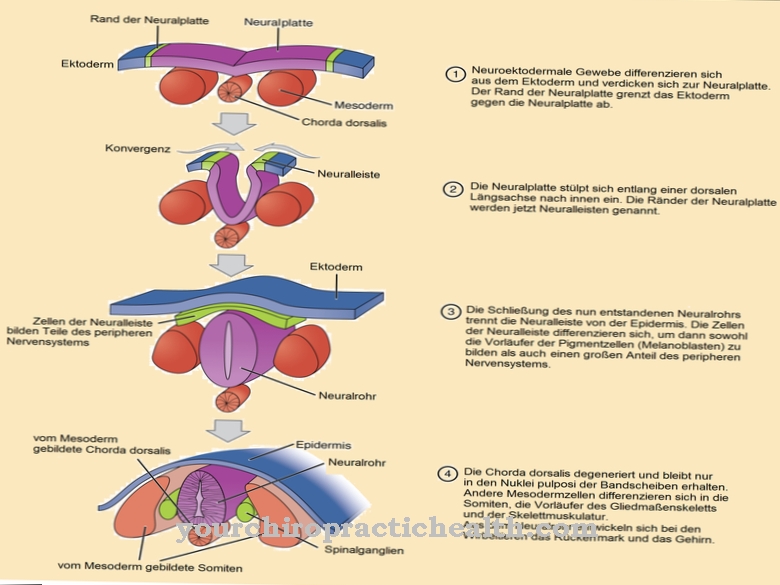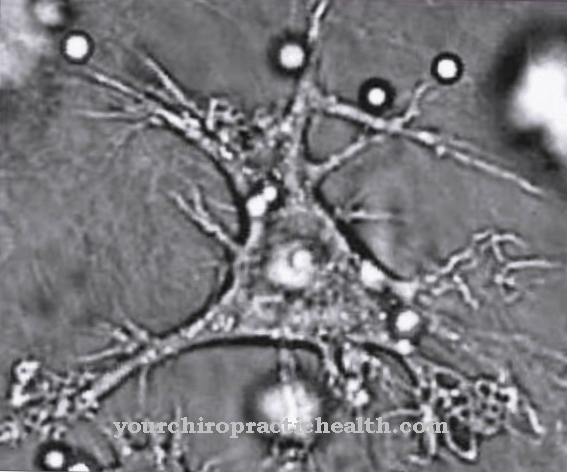The Calf muscles in the narrower sense, is composed of the two-headed calf muscle and the clod muscle. The main task of the calf muscles is to bend the foot downward, an extremely important function when walking, running, jumping and other movements.
What are the characteristics of the calf muscles?
Of the multitude of muscles in the calf area, only the two-headed calf muscle counts (Gastrocnemius muscle ) and the clod muscle (Soleus muscle ) to Calf muscles in the strict sense. Both muscles are often called the three-headed calf muscle (Triceps surae muscle ) summarized. Occasionally the long calf muscle (Plantaris muscle ) attributed to the triceps surae muscle because it also supports the downward flexion of the foot. The gastrocnemius muscle in particular gives the calf its typical appearance. The main task is to flex the foot downward.In order to be able to perform the task, the muscles at the upper end are connected to the lower part of the thigh bone and at the lower end they are fused with the heel bone, the calcaneus, via the Achilles tendon. The double-headed calf muscle is a strong skeletal muscle because the forces that act on the ankle joint - and thus on the calcaneus - when running and jumping can be enormous and are transferred from the Achilles tendon to the muscle.
Anatomy & structure
The gastrocnemius muscle has two heads above, the inner one Caput mediale and the side Caput lateralethat have grown on both sides of the lower end of the thighbone.
At the lower end, the muscle runs out into the Achilles tendon, which is connected to the rear end of the calcaneus and, via a strong leverage effect, can absorb forces that act on the ankle, for example through a jump, or transfer forces to the ankle, if a jump is intended.
The soleus muscle lies below the calf muscle and can be felt on the outside under the gastrocnemius muscle. The lower end of the muscle also opens into the Achilles tendon and is therefore connected to the calcaneus. The plantaris muscle, which some authors attribute to the calf muscles, also flows down into the Achilles tendon.
The muscle that runs below the large calf muscles is of little importance in humans, but also has a vascular protective function. The entire calf muscles are innervated by the tibial nerve (Tibial nerve), one of the two main branches of the sciatic nerve (Sciatic nerve) arising from the lumbo-sacral nerve plexus (Lumbosacral plexus) arises.Function & tasks
The main function of the calf muscles is to bend the foot or bend it downwards and to absorb forces that are transmitted from the calcaneus to the calf muscles via the Achilles tendon.
This is always the case when the foot is loaded without the heel being able to support itself on the ground. In another function, the gastrocnemius muscle supports the flexion of the knee or the lifting of the lower leg towards the buttocks. Another important function is to support supination - the outward rotation - of the foot.
It is about raising the inner edge of the foot, i.e. the right edge of the foot in the left foot and vice versa. At the same time, the outer edge of the foot is lowered. This can also be thought of as tilting the foot outwards. If the canting is provoked unprepared by external influences, for example by unnoticed unevenness or obstacles on the floor, this can result in overstretching or "twisting".
Supination is also assisted by other muscles such as the shin muscles and various toe flexors. The functions of the calf muscles described above play an important role in movement sequences in which static or dynamic loads are placed on the forefoot without the heel being able to support itself on the ground.
This applies not only to activities such as walking, running and jumping, but also to cycling, where the sole of the foot is not stressed, but primarily the ball of the foot.
You can find your medication here
➔ Medicines for muscle crampsIllnesses & ailments
Symptoms associated with the calf muscles can originate from the muscles themselves or from the nervous system. The most common and usually harmless form is sore muscles.
It usually occurs within 12 to 24 hours after the muscle concerned has been overloaded. It often occurs on the calf muscles after walking downhill on tarred roads for a long time. Another type of complaint that directly affects the muscle is muscle spasms, which manifest themselves in painful muscle contractions that can not be controlled at will for up to a minute.
In simple cases it is simply a disruption of the electrolyte balance, for example due to mineral loss due to heavy sweating. Heavy alcohol consumption and hyperventilation can also cause muscle cramps. Most often there is a decreased magnesium level.
So-called symptomatic cramps, which are causally caused by other primary diseases, can also occur. In this context, circulatory disorders and medication (e.g. diuretics, beta blockers) can play a role and should be clarified.
Apart from neuropathies, which can lead to muscle complaints, complaints that are caused by “pinched” nerves are particularly frequent, because the affected motor neurons, which stimulate the muscles to contract or relax, can only transmit signals to a limited extent.
Since the calf muscles from Tibial nerve is supplied with nerve impulses, its course must be examined for possible interruptions if only the calf muscles are nervously undersupplied.





.jpg)







.jpg)

.jpg)
.jpg)











.jpg)